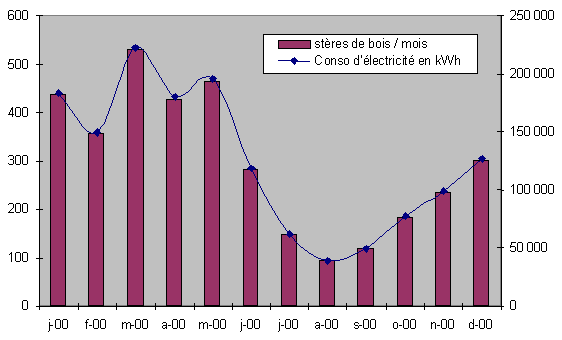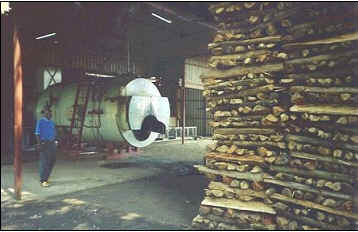SUPPLYING THE PFUNDA TEA FACTORY. | ||||
Economic studySome figures In these evaluations, the following energy equivalents
are assumed : The calorific energy of wood (generally eucalyptus in Rwanda) is more difficult to estimate. According to what has been written, the weight/volume ratio for a cubic metre (stere) of wood varies between 300kg per stere and 500 kg per stere. We believe that a value of about 350 kg/stere is close to reality. The PCI of wood will amount to 15 000 Kj/kg. The comparison
between wood and gas on the level of energy works out at : 1 stere of wood is
equivalent to 150 Nm3 of gas - that is about 5 GJ. Comparison of the price of wood and the price of fuel
oil in energy terms Note that the price of fuel oil is currently 8 or 9 times higher than wood, a fact which cannot be discounted in looking at the economic reality of the country : it would be difficult for methane to be cost competitive with wood. Methane would however be exceptionally competitive as a substitute for fuel oil. Prices given above may vary considerably with time.
One can foresee a continuous exponential increase in the price of wood with the
decrease in reserves and the increase in need. On the other hand it is difficult
to foresee the future concerning the price of fuel oil (a barrel of oil cost around
US$ 45 at the beginning of September 2004) . | Evaluation of energy needs of the Pfunda tea factoryTea production is a seasonal
occupation : so production at the Pfunda factory varies throughout the year. Energy
consumption shows this clearly, with a peak in March (178% of the monthly average)
and a low point in August (32% of the monthly average). The capacity for supplying
methane should thus be calculated on the period when most wood is used. Currently,
during March, in the middle of the rainy season, wood consumption for drying the
tea is about 20 steres per day. Due
to the wide variation in tea production over a year (see figure below) there will
be a surplus of methane available during the dry season. This gas could be sold
by UPEGAZ to Bralirwa, replacing fuel oil (in current conditions which is 90%of
the price of fuel oil, equivalent PCI) Figures for wood consumption 2004 - 2009 are even higher, because provisions envisage 5800 steres of wood per year (which would correspond to a maximum consumption of 27 steres per day). Thus the quantity of methane which could be sold to Bralirwa would be 730 000 Nm3 per year, the equivalent of 585 000 litres of fuel oil. Calculating on the basis of the
present price of fuel oil of 0.5 euros a litre and taking into account the reduction
of 90% compared to fuel oil, the sale to Bralirwa would bring UPEGAZ : - in the
present situation 760 000 x 0.5 X 0.9 = 342 000 euros a year; - in the hypothesis
of expansion : 585 x 0.5 x 0.9 = 263 000 euros a year. | |||
 | ||||
 |
Furthermore, for other parts of the production process, the Pfunda factory uses
about 1 950 000 KWh of electricity per year (information obtained from the management
in October 2003, with an average consumption of 1 500 000 KWh in 2002 for tea
production of 1 020 tonnes and an electricity bill of 63 M FRW, or US$ 105 000),
a consumption unequallty spread over the year. The factory also has a 450 Kva
generator which goes into service during power cuts or when the grid is not available,
(periods which account for 2 or 3 % of the time in 2003 (and probably much more
at present, in a period of electricity shortage). This amount of energy corresponds
to an additional consumption of about 58 000 KWh by the generator and a fuel oil
consumption of about 1.7 M FRW or US$ 2 800. | |||
Technical project for substituting methane for woodExtraction of methane from Lake Kivu.
| ||||
Transport of gas from Cape Rubona to the Pfunda factoryThe methane extraction plant will be a site chosen offshore from Cape rubona, about 1.5 km from the banks. | ||||
| ||||
| ||||




